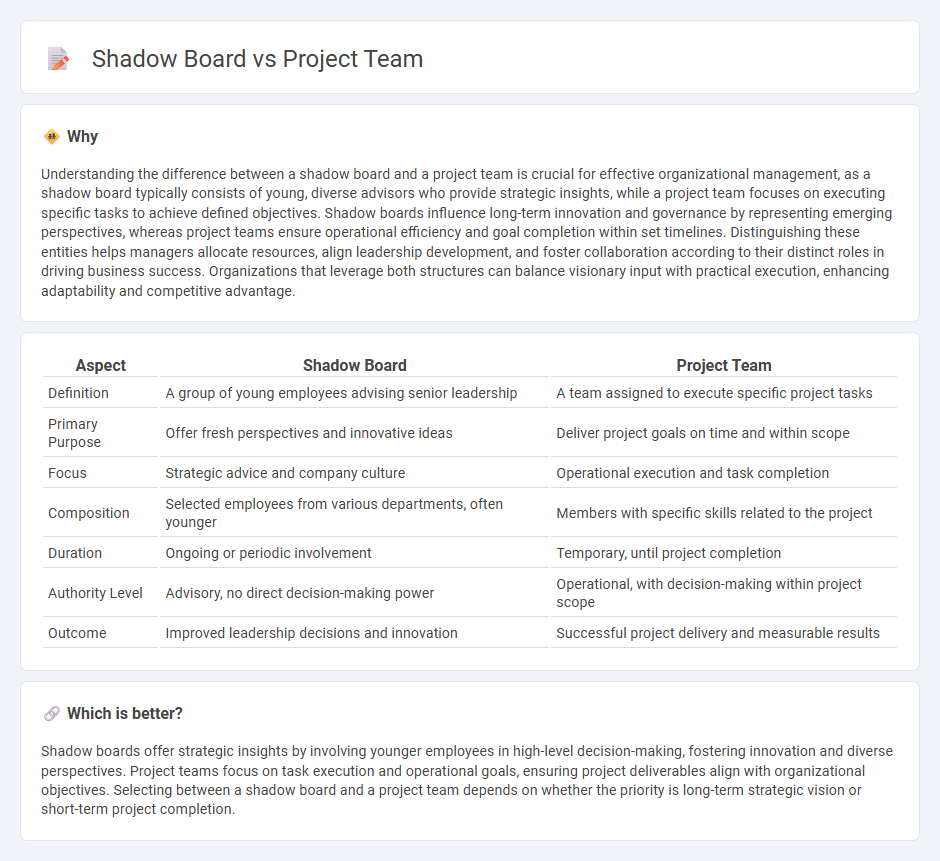
A shadow board consists of younger employees who provide strategic insights and innovative perspectives to senior management, fostering diversity and fresh ideas in decision-making. In contrast, a project team focuses on executing specific tasks and delivering project outcomes within set timelines, often involving cross-functional collaboration. Explore the distinct roles and benefits of shadow boards versus project teams to enhance organizational effectiveness.
Why it is important
Understanding the difference between a shadow board and a project team is crucial for effective organizational management, as a shadow board typically consists of young, diverse advisors who provide strategic insights, while a project team focuses on executing specific tasks to achieve defined objectives. Shadow boards influence long-term innovation and governance by representing emerging perspectives, whereas project teams ensure operational efficiency and goal completion within set timelines. Distinguishing these entities helps managers allocate resources, align leadership development, and foster collaboration according to their distinct roles in driving business success. Organizations that leverage both structures can balance visionary input with practical execution, enhancing adaptability and competitive advantage.
Comparison Table
| Aspect | Shadow Board | Project Team |
|---|---|---|
| Definition | A group of young employees advising senior leadership | A team assigned to execute specific project tasks |
| Primary Purpose | Offer fresh perspectives and innovative ideas | Deliver project goals on time and within scope |
| Focus | Strategic advice and company culture | Operational execution and task completion |
| Composition | Selected employees from various departments, often younger | Members with specific skills related to the project |
| Duration | Ongoing or periodic involvement | Temporary, until project completion |
| Authority Level | Advisory, no direct decision-making power | Operational, with decision-making within project scope |
| Outcome | Improved leadership decisions and innovation | Successful project delivery and measurable results |
Which is better?
Shadow boards offer strategic insights by involving younger employees in high-level decision-making, fostering innovation and diverse perspectives. Project teams focus on task execution and operational goals, ensuring project deliverables align with organizational objectives. Selecting between a shadow board and a project team depends on whether the priority is long-term strategic vision or short-term project completion.
Connection
A shadow board consists of emerging leaders who provide innovative insights and strategic advice, complementing the project team's execution capabilities by identifying potential risks and opportunities early in the process. Both entities collaborate to enhance decision-making, with the shadow board focusing on long-term vision and the project team driving day-to-day implementation. This connection fosters agile management, ensuring projects align with organizational goals while incorporating fresh perspectives.
Key Terms
Authority
Project teams typically hold formal authority to make decisions, allocate resources, and manage project execution, ensuring accountability and clear leadership within organizational hierarchies. Shadow boards, composed of emerging leaders or external advisors, generally possess advisory authority, influencing strategic direction without direct decision-making power. Explore deeper distinctions in authority dynamics and organizational impact to optimize governance structures.
Decision-making
Project teams concentrate on executing specific tasks and delivering outcomes within set timelines, often making operational decisions crucial to project success. Shadow boards consist of younger or less experienced employees who provide strategic insights and challenge senior management perspectives, influencing high-level decision-making processes. Explore how integrating both structures can enhance organizational agility and innovation.
Composition
Project teams typically consist of core members with clearly defined roles focused on executing specific tasks within a set timeline, emphasizing operational efficiency and expertise. Shadow boards are composed predominantly of younger employees or diverse members who provide strategic insights and innovative perspectives without direct decision-making power, fostering fresh ideas and cultural alignment with emerging trends. Explore how different compositions impact organizational agility and innovation by learning more.
Source and External Links
What is a project team? Plus, why your enterprise needs one - Asana - A project team is a cross-functional group, typically led by a project manager, that includes individuals from various departments working together to achieve a shared project goal, with responsibilities for delivering the project on time and according to objectives.
Project Team Roles and Responsibilities in Project Management - A project team consists of individuals with diverse skills collaborating toward common objectives, with typical roles including project manager, team members, sponsor, stakeholders, and business analyst.
Project team roles and responsibilities (with examples) - The five major roles in a project team are project sponsor, project manager, business analyst, resource manager, and team members, each contributing unique skills and responsibilities to ensure project success.
 dowidth.com
dowidth.com